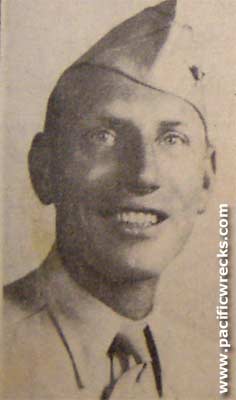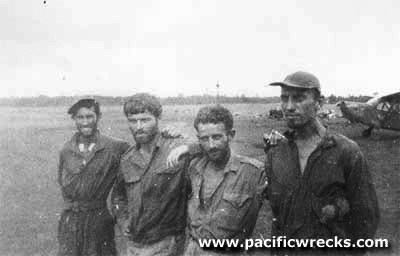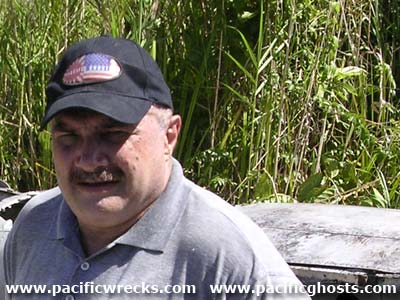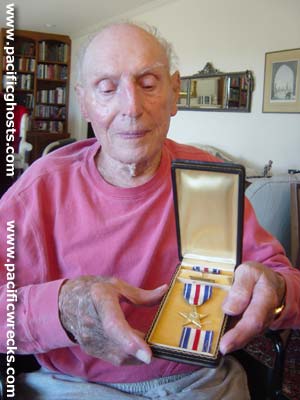The Nelson Flack Incident
A Failed Rescue Attempt, Daring Escape and Rediscovery of the Crash Site
by John
Douglas
February 14, 1944 Mission Over Wewak
In February 1944 the Allies in New
Guinea were fighting Japanese Forces on the ground along the Rai
Coast to the east of Madang; and in the mountains behind the Rai
Coast as well. Madang was finally occupied by Allied forces on
15th April 1944. The Ramu River valley behind Madang was in Japanese
hands throughout all of February and March 1944.
On February
14, 1944, the 49th Fighter Group took off from Gusap Airfield to attack enemy forces at Wewak. in the Ramu/Markham Valley. The 49th Fighter Group consisted of
3 Fighter Squadrons, the 7th, 8th and 9th. Nelson Flack was a
Lieutenant in the 8th Fighter Squadrons; and that day he claimed a Ki-61 Tony shot down into the sea. Other 49th FG claims that day totaled (8 – 1
Tony and 7 Oscars). However, Imperial Japanese Army Air Force (JAAF)
records acknowledged losses (of pilots) for that day total only 2
(1 Tony and 1 Oscar). The Tony was flown by Sgt. Major Rokusaburo
Nakamura of the 68th Hiko Sentai. However, Japanese records indicate
that he was killed in a accident, not in combat.
Crash Landing
During the aerial dual Nelson Flack's
P-40N Warhawk 42-104986 was damaged. On the return from Wewak to Gusap he lost power and
was forced to put down in a kunai (grass) patch near the Ramu River,
in enemy held territory. His report indicates that as he attempted to
land in the kunai, but his plane stalled in the approach, hit a tree,
lost the propeller and, slid across the kunai before hitting a small
hill. He was knocked out by the impact. When he recovered, he found that
he had a broken arm and a severe gash on his forehead, caused by hitting
the cockpit fittings. After he escaped from his plane, he set it on fire,
to prevent it falling into Japanese hands (another version is that the
plane exploded from petrol fumes coming in contact with the hot engine).
 L-5 To the Rescue, Also Crashes L-5 To the Rescue, Also Crashes
The same day a 25th
Liaison Squadron pilot Sgt.
Eugene Salternik, attempted to land
his small observation plane a Stinson
L-5 in
a nearby kunai patch, but the L-5 somersaulted on landing in the
rough, long grass. Salternik was not hurt. The 25th Liaison Squadron
had only arrived in Nadzab three days earlier and this was their first
full frontal taste of operations. It took him a further day to
reach the P-40 wreck.
Australian
Commando Parachuted To Site
 Nelson
Flack had been seen to land by his colleagues and the resultant smoke
from his wreck served to provide a guide to both allies and to the enemy.
At Gusap his crash was reported to the Commanding Officer, and it was
quickly decided, due to the ruggedness of the terrain, its remoteness,
and because it was behind enemy lines; that an Australian
Commando Hector Henstridge, would parachute
into the site and help Nelson walk out. Henstridge had only flown once
before in his life, and certainly had never parachuted before. Still,
this was a time of war and emergencies call for special solutions. Hector
landed near the wreck on day 2 and found Nelson missing from the site.
He had wandered off. Nelson
Flack had been seen to land by his colleagues and the resultant smoke
from his wreck served to provide a guide to both allies and to the enemy.
At Gusap his crash was reported to the Commanding Officer, and it was
quickly decided, due to the ruggedness of the terrain, its remoteness,
and because it was behind enemy lines; that an Australian
Commando Hector Henstridge, would parachute
into the site and help Nelson walk out. Henstridge had only flown once
before in his life, and certainly had never parachuted before. Still,
this was a time of war and emergencies call for special solutions. Hector
landed near the wreck on day 2 and found Nelson missing from the site.
He had wandered off.
"Flack Field"
The three of them then set out to create
a small, landing strip near the P-40, but without tools it proved
to be quite difficult. They achieved a small partially prepared area
by the expedient of rolling their bodies in the grass. Gradually
a small strip was created. It was the custom in New Guinea at that
time by the allied airforces command to name airstrips after well
known (and usually deceased) aviators. The strip become known to
these men as "Flack Field".
Another L-5 Attempts To Land
Six days after Nelson
Flack went in, a second L-5 piloted by Sgt. James Nichols, attempted
to land at Flack Field. This rough landing he broke his propeller,
and the wheel gear struts were bent as well. 3 wrecks! The next day
a third L5 pilot – Tom
Stallone – successfully
landed at Flack Field. It was judged impractical for him to recover
anybody, so he took off successfully and returned to Gusap by himself.
Back at Gusap a decision was taken not to invest any more planes
and pilots in this particular recovery.
Trek To Rescue Themselves
 The
four men now had no option but to walk out. This they did successfully,
taking 21 days in all. Their friends were able for a short period
to follow the men on their expedition to freedom but eventually lost
contact. After a few days they were declared missing in action, presumed
captured by the enemy forces present in the area. The trip out to
freedom took a real toll on all of the men, Nichols wasting away
to 90 pounds. All of their shoes rotted and Nichols had to be stretchered
the last 20 miles. After recovery and rest they all eventually returned
to duty. There is a photograph of the men when they reached Faita. It clearly shows the strain that they have been exposed
to. No smiles there. Then, the were returned to Gusap. The
four men now had no option but to walk out. This they did successfully,
taking 21 days in all. Their friends were able for a short period
to follow the men on their expedition to freedom but eventually lost
contact. After a few days they were declared missing in action, presumed
captured by the enemy forces present in the area. The trip out to
freedom took a real toll on all of the men, Nichols wasting away
to 90 pounds. All of their shoes rotted and Nichols had to be stretchered
the last 20 miles. After recovery and rest they all eventually returned
to duty. There is a photograph of the men when they reached Faita. It clearly shows the strain that they have been exposed
to. No smiles there. Then, the were returned to Gusap.
RAAF Visit Wrecks in 1946
 This
is a great survival story from the war years in PNG; and there are
many other great stories as well that can be recounted. What made
this story so interesting to me was the loss of 3 planes in the same
incident. One of several follow up reports on the incident
was subsequently filed by the RAAF in 1946; when they were searching
the area; looking for the remains of missing Australian airmen. This
is a great survival story from the war years in PNG; and there are
many other great stories as well that can be recounted. What made
this story so interesting to me was the loss of 3 planes in the same
incident. One of several follow up reports on the incident
was subsequently filed by the RAAF in 1946; when they were searching
the area; looking for the remains of missing Australian airmen.
At
that time their report noted that “the tail of the
P-40 was marked in green and white checkerboard pattern, the
right side of the fin bore the numbers 986 and the left side 210.
(Flacks aircraft was P-40N Warhawk 42-104986). Although burnt around
the engine and cockpit the aircraft appeared to have made a good
crash landing. About 80 yards away is a Vultee Stinson L-5”.
The RAAF did not locate the second Stinson L-5
was a mile away (Salternik's).
Over the past 60 years a number of semi - official
histories have been written up of the combat record of the 49th Fighter
Group and also of the activities of the 25th Liaison Sq. (of the 71st
Technical Recon Group) and each of these – inevitably – deals
at some length – on
this incident. These histories are all “good yarns” but
are short on the specifics of the location, and any subsequent history
of the planes involved.
Search For The Aircraft Wrecks
 I
have been interested in the war history in Papua New Guinea since
I arrived in country in 1989. This interest; sometimes a compulsion,
always a passion has taken me to many of the aircraft wrecks that
still remain in the country, nearly 60 years after the end of the
combat. I have also dived on plane and ship wrecks in the sea, interviewed
and recorded the reminisces of Papua New Guineans who recall those
times and visited battlefield sites as well. I have become an amateur
expert on these times and places and am often consulted by others
who seek information on particular circumstances from that era. I
have been interested in the war history in Papua New Guinea since
I arrived in country in 1989. This interest; sometimes a compulsion,
always a passion has taken me to many of the aircraft wrecks that
still remain in the country, nearly 60 years after the end of the
combat. I have also dived on plane and ship wrecks in the sea, interviewed
and recorded the reminisces of Papua New Guineans who recall those
times and visited battlefield sites as well. I have become an amateur
expert on these times and places and am often consulted by others
who seek information on particular circumstances from that era.
The “Flack incident” is one of about
40-50 stories that I keep an eye on. As far as I can tell from my inquiries
and research; no one had been to the site since 1946 when the RAAF
searchers visited briefly, apart from the local villagers. I have access
to, or own copies of most of the records and histories of the various
forces: American, Australian, New Zealand and Japanese. I also have
a number of lists, complied by myself and others of various wreck locations
throughout PNG that is constantly scrutinized and added to.
Flacks P-40 appeared to have been unvisited because
of its considerable remoteness. With literally thousands of wrecks
in the country there are plenty of other options for the curious
to visit should they wish to seek out plane wrecks. This wreck is
one of many that I would like to visit, but to get to it requires
helicopter time that I can normally not easily afford; so for several
years I have been waiting for the chance. That chance came in early
2004 that I was able to visit the scene of the “Flack
Incident”.
Visiting Nearby Villages
 The
visit was actually made twice. The first trip was to locate the village
near where the wreck was reported in 1946 and if possible to locate
and inspect the wreckage. This goal proved somewhat optimistic. The
village had relocated itself by some three kilometers from its last reported
position and took considerable time to locate even with a helicopter. We visited three other villages in the general area
before successful in locating villagers who claimed to know of aircraft
wrecks that seemed to fit the particular description I was able to
provide. The
visit was actually made twice. The first trip was to locate the village
near where the wreck was reported in 1946 and if possible to locate
and inspect the wreckage. This goal proved somewhat optimistic. The
village had relocated itself by some three kilometers from its last reported
position and took considerable time to locate even with a helicopter. We visited three other villages in the general area
before successful in locating villagers who claimed to know of aircraft
wrecks that seemed to fit the particular description I was able to
provide.
Further discussion in pidgin with the villagers
indicated “Yes
we have three plane wrecks, but one was burnt and is of no value; all
three have only one engine each and no, they did not know what had
happened to the pilots." This all seemed to good to be true. A bit
of faith was called for. They were asked to clear a space for a helicopter
to land near the wreckage and were given a date of return. I advised
that we would be back in three weeks time.
As we left, we were given
a list of vital community needs, from school books and medicines
to a guitar and watches that we should bring on our return. It was
certainly an act of faith (or foolishness) that we committed ourselves
to return, as the planes may not have existed (villagers sometimes
give positive responses to any query), or they may not have cleared
the landing areas (the chopper couldn't’t
land in the kunai, as the grass was to long for the tail rotor) on
this first visit.
I had a few anxious moments over the next three weeks. Would it all
work out? Was my research accurate (often these records are general only
as to location, or the historic observer was not skilled at map reading);
or perhaps the wrecks been destroyed or damaged in the last 60 years.
The truth is rarely as expected or predicted. I kept these natural doubts
to myself.
Eventually the day for our return arrived. The number of curious was down
this time from 5 to 3. This gave more space for us inside on the journey. We returned to the village and landed in the
garden again. Anxious queries from me soon produced the claim that
the landing pads had been cleared and that most of the small village
population was on site (it was a good days walk away); waiting for
us. I handed the guitar and school supplies over to the “stay behinds”,
and we helicoptered off with a local guide, his first
ride in a helicopter. A few minutes flight across the dense heavy forest took us to a kunai
patch and a smudge fire. The pipe framework of a small plane was visible
in the middle of a recently burnt kunai patch. The chopper landed; I
and the guide got out, and the chopper returned for my colleagues.
L-5 Serial Number 42-98066
 I inspected the wreckage. It was clearly an upside down L5, with all
that remained being the body and tail frame of piping, and an engine,
still with its cowl present The wings had disintegrated. This looked
very much like Salterniks plane, which was recorded as being capsized,
in a clearing about a mile away from the other planes. No serial numbers
were obvious. The expedition was looking good. Questioning the local people who had gathered
there for the fun and entertainment, they said the other plane wrecks
were several hours walk away, and that an area had also been cleared
at that place for the helicopter to land. After a period for photography
and contemplation, I returned to the helicopter which had now arrived
and flew to the second location. I inspected the wreckage. It was clearly an upside down L5, with all
that remained being the body and tail frame of piping, and an engine,
still with its cowl present The wings had disintegrated. This looked
very much like Salterniks plane, which was recorded as being capsized,
in a clearing about a mile away from the other planes. No serial numbers
were obvious. The expedition was looking good. Questioning the local people who had gathered
there for the fun and entertainment, they said the other plane wrecks
were several hours walk away, and that an area had also been cleared
at that place for the helicopter to land. After a period for photography
and contemplation, I returned to the helicopter which had now arrived
and flew to the second location.
This took some time as the local guide could
not initially identify the site. Eventually, after a change of guide
I arrived at a small clearing in light forest. The clearing had left
several foot high stumps which the pilot had to avoid in a very skilled
landing. I got out with two local guides and while the pilot returned
for my colleagues we tried to make the pad safer for follow up landings.
Considerable debris was removed (mainly logs and branches) and several
stumps cut down to ground level. After half an hour of frantic activity
the site was much cleaner and I could relax while waiting the chopper’s
return. I was sweating freely. As soon as I slowed down the dreaded “sweat
bees” arrived.
These bees are not toxic or poisonous, but do enjoy a good drink
of sweat in the hot humid climate that we were in. They are a local
pest – known
and dreaded throughout the Ramu Valley. In the mid morning they
were a minor pest but became a real bother as the day wore on,
with literally hundreds on my body and clothes at any one time.
L-5 "Termite" Serial Number 42-98085
On the other side of the clearing was a second pipe frame plane wreck.
This one was upright, with the wings gone (made of timber and canvas).
The landing gear was buried in the soil but the body was in much
better condition than the first wreck. It had been under forest cover
for several decades as the forest succession had replaced the kunai
and had consequently avoided the occasional grass fire that had affected
the first wreck.
The expedition was looking more and more successful.
The wrecks were exactly where the official records made them out
to be. They had been practically undisturbed. I had not yet seen
the P-40 wreck, but I felt relief that my research proved I had been
accurate as to description and to location (at least for the two
L5s). I also felt excitement and pleasure that goes with such adventures
of effort and success; of anticipation fulfilled.
The
helicopter returned with my companions and after some maneuvering
made a successful landing. It was a long way to walk out, and we
didn’t
want to repeat the trials of the airmen of 1944. My companions were
anxious to see the P-40, and the guides told us it was a short
walk through the forest. The forest appeared to have grown up since
the war years and consisted mainly of light trees, no more than
50-60’ high, with a leaf
covered forest floor, which made walking easy.
P-40N Warhawk Serial Number 42-104986
 Subsequent research
has revealed that Sgt. Stallone died in New Guinea during the War
whilst the rest survived. Nelson Flack was killed in Korea. Both Sgt. Nelson and Lt. Hestridge have since departed this
life, but Eugene
Salternik is a sporty 92 year old living in Southern
California. Subsequent research
has revealed that Sgt. Stallone died in New Guinea during the War
whilst the rest survived. Nelson Flack was killed in Korea. Both Sgt. Nelson and Lt. Hestridge have since departed this
life, but Eugene
Salternik is a sporty 92 year old living in Southern
California.
References
Eugene
Salternik interview
Additional research by Justin Taylan and Phil
Bradley
Ghost
Wings Magazine Issue 12 "Skeletons in the Grass - An Epic WWII
Rescue" by John Douglas & Justin Taylan
Contribute Information
Do you have photos or additional information to add?
|